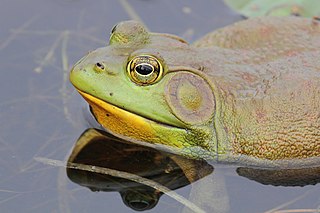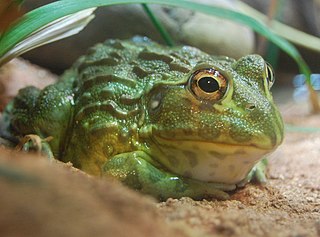
Leiopelma is a genus of New Zealand primitive frogs, belonging to the suborder Archaeobatrachia. It is the only genus in the monotypic family Leiopelmatidae. The leiopelmatids' relatively basal form indicates they have an ancient lineage. While some taxonomists have suggested combining the North American frogs of the genus Ascaphus in the family Ascaphidae with the New Zealand frogs of the genus Leiopelma in the family Leiopelmatidae, the current consensus is that these two groups constitute two separate families. The three extant species of Leiopelmatidae are only found in New Zealand.

The Microhylidae, commonly known as narrow-mouthed frogs, are a geographically widespread family of frogs. The 683 species are in 57 genera and 11 subfamilies.

The Rhacophoridae are a family of frogs in tropical sub-Saharan Africa, South India and Sri Lanka, Japan, northeastern India to eastern China and Taiwan, south through the Philippines and Greater Sundas, and Sulawesi. They are commonly known as shrub frogs, or more ambiguously as "moss frogs" or "bush frogs". Some Rhacophoridae are called "tree frogs". Among the most spectacular members of this family are numerous "flying frogs".

Rana is a genus of frogs commonly known as the Holarctic true frogs, pond frogs or brown frogs. Members of this genus are found through much of Eurasia and western North America. Many other genera were formerly included here. These true frogs are usually largish species characterized by their slim waists and wrinkled skin; many have thin ridges running along their backs, but they generally lack "warts" as in typical toads. They are excellent jumpers due to their long, slender legs. The typical webbing found on their hind feet allows for easy movement through water. Coloration is mostly greens and browns above, with darker and yellowish spots.

The glass frogs belong to the amphibian family Centrolenidae, native to the Central American Rainforests. The general background coloration of most glass frogs is primarily lime green, the abdominal skin of some members of this family is transparent and translucent, giving the glass frog its common name. The internal viscera, including the heart, liver, and gastrointestinal tract, are visible through the skin. When active their blood makes them visible; when sleeping most of the blood is concealed in the liver, hiding them. Glass frogs are arboreal, living mainly in trees, feeding on small insects and only coming out for mating season. Their transparency conceals them very effectively when sleeping on a green leaf, as they habitually do. However, climate change and habitat fragmentation has been threatening the survival rates of the family.

Litoria is a genus of hylid tree frogs, sometimes collectively referred to as Australasian treefrogs.

Pseudacris is a genus of frogs in the family Hylidae found in North America ranging from the Pacific coastline to the Atlantic.

Crinia is a genus of frog, native to Australia, and part of the family Myobatrachidae. It consists of small frogs, which are distributed throughout most of Australia, excluding the central arid regions. Many of the species within this genus are non-distinguishable through physical characteristics, and can only be distinguished by their calls.

The Leptodactylinae are a subfamily of leptodactylid frogs distributed between southern North America and South America to Brazil. Their sister taxon is the clade comprising the Leiuperinae and Paratelmatobiinae.

Leptodactylus is a genus of leptodactylid frogs. It includes the species commonly called ditch frogs or white-lipped frogs. It is very similar to Physalaemus, a close relative, and indeed the 2005 described Leptodactylus lauramiriamae is in some aspects intermediate between them.

Polypedates is a genus of frogs in the family Rhacophoridae, the shrub frogs and Paleotropic tree frogs. They belong to subfamily Rhacophorinae. Members of this genus are collectively known as whipping frogs. They occur in eastern and southern Asia.

Rheobatrachus, whose members are known as the gastric-brooding frogs or platypus frogs, is a genus of extinct ground-dwelling frogs native to Queensland in eastern Australia. The genus consisted of only two species, the southern and northern gastric-brooding frogs, both of which became extinct in the mid-1980s. The genus is unique because it contains the only two known frog species that incubated the prejuvenile stages of their offspring in the stomach of the mother.

Lithobates, commonly known as the bullfrogs, is a genus of true frogs, of the family Ranidae. The name is derived from litho- (stone) and the Greek bates, meaning one that treads on rock, or rock climber. As presently defined, it includes many of eastern North America's most familiar aquatic frog species, including the American bullfrog, green frog, and the leopard frogs.

Hydrolaetare schmidti is a species of frog in the family Leptodactylidae. It has a scattered distribution in the Amazon Basin in Brazil, Colombia, French Guiana, and Peru. Its natural habitats are subtropical or tropical moist lowland forest, subtropical or tropical swamps, rivers, and freshwater marshes. It is named after Karl Patterson Schmidt, American herpetologist.

A tree frog is any species of frog that spends a major portion of its lifespan in trees, known as an arboreal state. Several lineages of frogs among the Neobatrachia suborder have given rise to treefrogs, although they are not closely related to each other.

The Pyxicephalidae are a family of frogs currently found in sub-Saharan Africa. However, in the Eocene, the taxon Thaumastosaurus lived in Europe.
Hyaloklossia is a genus of parasitic alveolates in the phylum Apicomplexa. Only two species in this genus are currently recognised.

Robert Frederick Inger was an American herpetologist. During his lifetime, he wrote numerous books and publications about herpetology. He was also the curator for amphibians and reptiles at the Field Museum in Chicago, Illinois.
The forest frog (Platymantis) is a genus of frogs in the family Ceratobatrachidae found in the Philippines, Palau, Fiji, New Guinea, and in the Admiralty, Bismarck, and Solomon Islands.
















